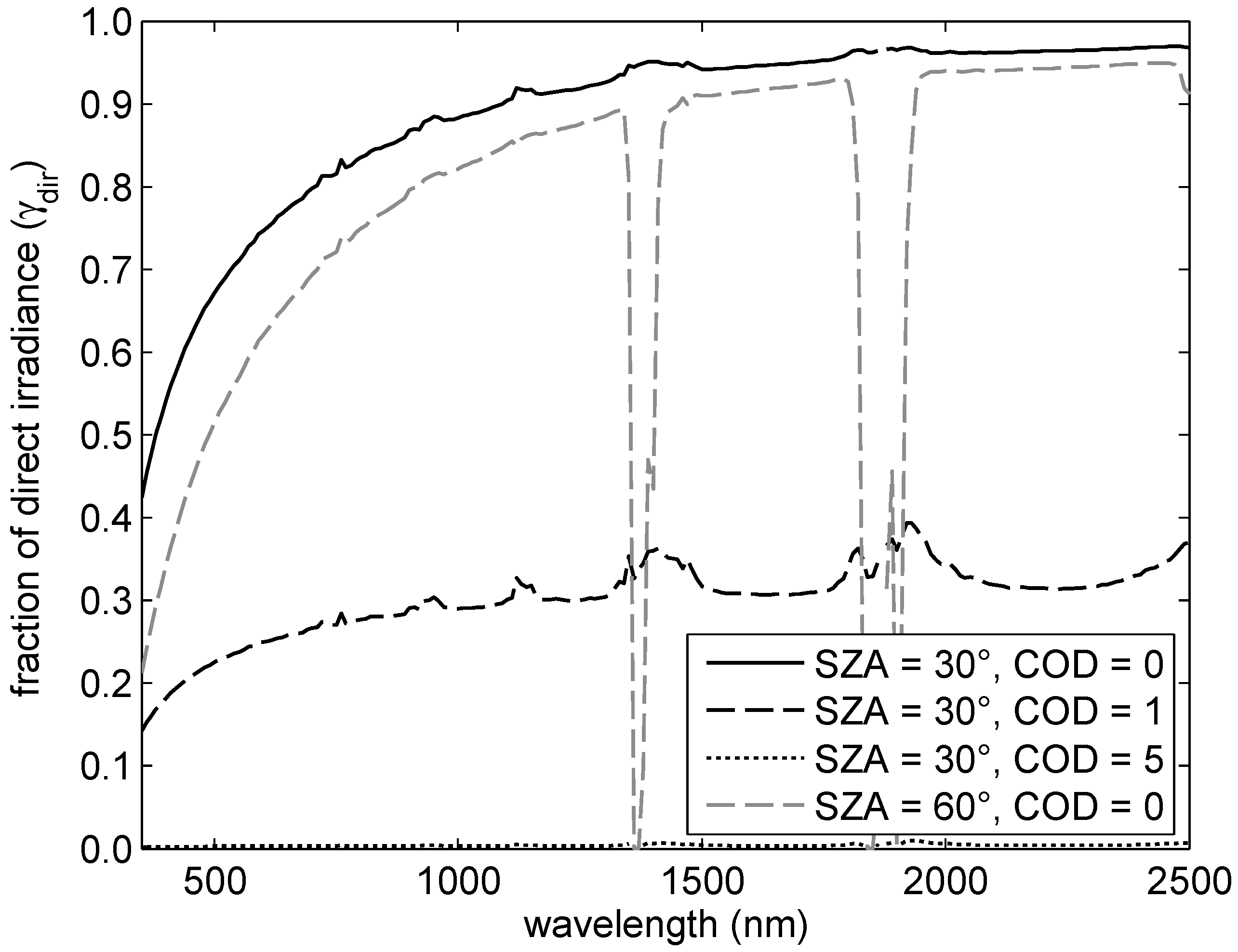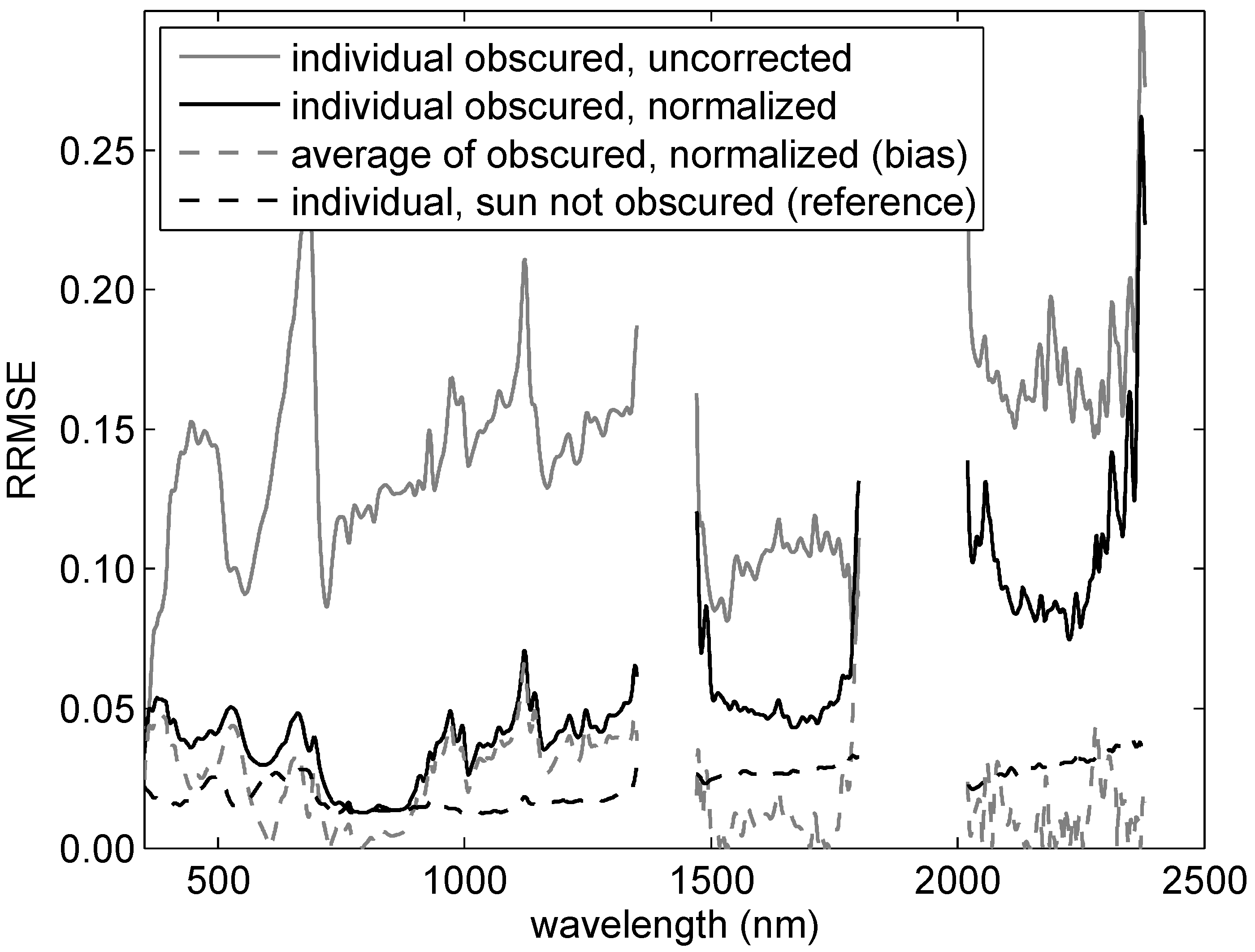Evaluation and Normalization of Cloud Obscuration Related BRDF Effects in Field Spectroscopy
Abstract
:1. Introduction
- •
- to gain better insights in the mechanisms in which different levels of cloud obscuration affect DFOV spectroscopy. More specifically, the focus will be put on the effects of decreased irradiance (noise level) and target/whitepanel BRDF.
- •
- to evaluate whether, for measurement series over similar targets, the target BRDF can be decomposed into an isotropic target-specific component and a group-specific bidirectional component.
- •
- to use this decomposition for developing a data-driven normalization procedure for converting, by means of an initial dataset obtained from a representative target, measured reflectance factors into reproducible reflectance measures, independent of cloud obscuration.
2. Theoretical Background
2.1. Overview of Radiometric Units
| Symbol | Name | Units |
|---|---|---|
| L | radiance | |
| spectral radiance | ||
| E | irradiance | |
| spectral irradiance | ||
| f | BRDF or bidirectional reflectance | |
| ρ | reflectance factor | - |
| γ | fraction of direct irradiance | - |
2.2. Processing of Dual Field of View Measurements
2.3. Impact of Cloud Obscuration on Signal Noise
2.4. BRDF Effects Caused by Illumination Conditions
2.5. Normalization Factor for Dual-Beam BRDF Effects
3. Materials and Methods
3.1. Field Measurements
| target | day, time | solar zenith (°) | min. irradiance () | max. irradiance () |
|---|---|---|---|---|
| Citrus tree canopies (set 1) | 8-24-2008, 13h10 | 41° | 158 | 886 |
| Citrus tree canopies (set 2) | 30-4-2009, 13h00 | 36° | 190 | 859 |
| grass sod (0.05 m height) | 9-10-2008, 14h00 | 46° | 160 | 752 |
| grass sod (0.05 m height) | 9-10-2008, 17h00 | 63° | 136 | 385 |
| gravel | 9-11-2008, 14h00 | 46° | 203 | 785 |
3.2. Ray Tracing Simulations
4. Results and Discussion
4.1. Impact of Cloud Cover on the Signal-to-Noise Ratio

4.2. Wavelength Dependency of Fraction of Diffuse Radiance and Weight Function


4.3. Impact of Reference Panel BRDF

4.4. Effect of Fluctuations in COD and Irradiance During Scan Time

4.5. Evaluating the Decomposition of the Target BRDF

4.6. Interpretation of Measured BRDF Effects

4.7. Data-Driven Normalization



5. Conclusions
Acknowledgments
Appendix
References
- Milton, E.; Schaepman, M.; Anderson, K.; Kneubühler, M.; Fox, N. Progress in field spectroscopy. In IEEE International Conference on Geoscience and Remote Sensing Symposium, IGARSS 2006, Denver, CO, USA, July 31–August 4, 2006; pp. 1966–1968.
- ASD Technical Guide, 3rd ed.; Analytical Spectral Devices: Boulder, CO, USA, 1999.
- Milton, E.; Rollin, E.; Emery, D. Advances in Environmental Remote Sensing; Wiley: Chichester, UK, 1995; pp. 9–32. [Google Scholar]
- Sandmeier, S.R. Acquisition of bidirectional reflectance factor data with field goniometers. Remote Sens. Environ. 2000, 73, 257–269. [Google Scholar] [CrossRef]
- Milton, E.; Rollin, E. Estimating the irradiance spectrum from measurements in a limited number of spectral bands. Remote Sens. Environ. 2006, 100, 348–355. [Google Scholar] [CrossRef]
- Anderson, K.; Milton, E.; Rollin, E. Calibration of dual-beam spectroradiometric data. Int. J. Remote S. 2006, 27, 975–986. [Google Scholar] [CrossRef]
- Milton, E.; Goetz, A. Atmospheric influences on field spectrometry: observed relationships between spectral irradiance and the variance in spectral reflectance. In Seventh International Symposium on Physical Measurements and Signatures in Remote Sensing, Courchevel, France, April 7-11, 1997; Vol. 1, pp. 109–114.
- Gilabert, M.-A.; Meliá, J. Solar angle and sky light effects on ground reflectance measurements in a citrus canopy. Remote Sens. Environ. 1993, 45, 281–293. [Google Scholar] [CrossRef]
- Abdou, W.A.; Helmlinger, M.C.; Conel, J.E.; Bruegge, C.J.; Pilorz, S.H.; Martonchik, J.V. Ground measurements of surface BRF and HDRF using PARABOLA III. J. Geophys. Res. 2000, 106, 967–976. [Google Scholar] [CrossRef]
- Sandmeier, S.; Müller, C.; Hosgood, B.; Andreoli, G. Sensitivity analysis and quality assessment of laboratory BRDF data. Remote Sens. Environ. 1998, 64, 176–191. [Google Scholar] [CrossRef]
- Rollin, E.; Milton, E.; Emery, D. Reference panel anisotropy and diffuse radiation - some implications for field spectroscopy. Int. J. Remote Sens. 2000, 21, 2799–2810. [Google Scholar] [CrossRef]
- Bruegge, C.; Chrien, N.; Haner, D. A spectralon BRF data base for MISR calibration applications. Remote Sens. Environ. 2001, 76, 354–366. [Google Scholar] [CrossRef]
- Michalsky, J.; Harrison, L.; Berkheiser, W. Cosine response characteristics of some radiometric and photometric sensors. Sol. Energy 1995, 54, 397–402. [Google Scholar] [CrossRef]
- Schott, J. Remote Sensing: The Image Chain Approach, 2th ed.; Oxford Press: New York, NY, USA, 2007. [Google Scholar]
- Kimes, D.; Kirchner, J. Irradiance measurement errors due to the assumption of a Lambertian reference panel. Remote Sens. Environ. 1982, 12, 141–149. [Google Scholar] [CrossRef]
- Gu, X.; Guyot, G. Effects of diffuse irradiance on the reflectance factor of reference panels under field conditions. Remote Sens. Environ. 1993, 45, 249–260. [Google Scholar] [CrossRef]
- Flasse, S.; Verstraete, M.; Pinty, B.; Bruegge, C. Modeling Spectralon’s bidirectional reflectance for in-flight calibration of Earth-orbiting sensors. In Proc. SPIE, 1993, Orlando, FL, USA, April 16, 1993.
- Schopfer, J. Spectrodirectional ground-based remote sensing using dual-view goniometry: field BRF retrieval and assessment of the diffuse irradiance distribution in spectrodirectional field measurements. PhD thesis, University of Zurich, Zurich, Switzerland, 2008. [Google Scholar]
- Platt, U.; Pfeilsticker, K.; Vollmer, M. Springer Handbook of Lasers and Optics; Springer: New York, NY, USA, 2007; pp. 1165–1203. [Google Scholar]
- CIE, Spatial distribution of daylight-CIE Standard General Sky; Technical Report CIE Standard S 011/E:2003; CIE Central Bureau: Vienna, Austria, 2003.
- Lucht, W.; Schaaf, C.; Strahler, A. An algorithm for the retrieval of albedo from space using semiempirical BRDF models. IEEE T. Geosci. Remote Sens. 2000, 38, 977–998. [Google Scholar] [CrossRef]
- Giavis, G.; Kambezidis, H.; Sifakis, N.; Toth, Z.; Adamopoulos, A.; Zevgolis, D. Diurnal variation of the aerosol optical depth for two distinct cases in the Athens area, Greece. Atmosph. Res. 2005, 78, 79–92. [Google Scholar] [CrossRef]
- Igawa, N.; Koga, Y.; Matsuzawa, T.; Nakamura, H. Models of sky radiance distribution and sky luminance distribution. Sol. Energy 2004, 77, 137–157. [Google Scholar] [CrossRef]
- HR-1024 User Manual, rev. 1.3 ed.; Spectra Vista Corporation: New York, NY, USA, 2008.
- Pharr, M.; Humphreys, G. Physically Based Rendering: From Theory to Implementation; Morgan Kaufmann: San Francisco, CA, USA, 2004. [Google Scholar]
- Widlowski, J.-L.; Robustelli, M.; Disney, M.; Gastellu-Etchegorry, J.-P.; Levergne, T.; Lewis, P.; North, P.; Pinty, B.; Thompson, R.; Verstraete, M. The RAMI On-line Model Checker (ROMC): A web-based benchmarking facility for canopy reflectance models. Remote Sens. Environ. 2008, 112, 1144–1150. [Google Scholar] [CrossRef] [Green Version]
- Stuckens, J.; Somers, B.; Delalieux, S.; Verstraeten, W.; Coppin, P. The impact of common assumptions on canopy radiative transfer simulations: A case study in Citrus orchards. J. Quant. Spectrosc. Ra. 2009, 110, 1–21. [Google Scholar] [CrossRef]
- Jacquemoud, S.; Baret, E.; Hanocq, J. Modeling spectral and bidirectional soil reflectance. Remote Sens. Environ. 1992, 41, 123–132. [Google Scholar] [CrossRef]
- Bunnik, N.J.J. The Multispectral Reflectance of Shortwave Radiation of Agricultural Crops in Relation with Their Morphological and Optical Properties. PhD Thesis, Mededelingen Landbouwhogeschool Wageningen, Wageningen, The Netherlands, 1975. [Google Scholar]
- Hosgood, B.; Jacquemoud, S.; Andreoli, G.; Verdebout, J.; Pedrini, A.G.S. Leaf Optical Properties EXperiment 93 (LOPEX93); Technical report; Joint Research Centre, Institute for Remote Sensing Applications, Unit for Advanced Techniques, TP 272: Ispra (VA), Italy, 1994. [Google Scholar]
- Somers, B.; Delalieux, S.; Verstraeten, W.; Coppin, P. A conceptual framework for the simultaneous extraction of sub-pixel spatial extent and spectral characteristics of crops. Photogramm. Eng. Remote Sens. 2009, 1, 57–68. [Google Scholar] [CrossRef]
- Bousquet, L.; Lachérade, S.; Jacquemoud, S.; Moya, I. Leaf BRDF measurements and model for specular and diffuse components differentiation. Remote Sens. Environ. 2005, 98, 201–211. [Google Scholar] [CrossRef]
- Ricchiazzi, P.; Yang, S.; Gautier, C.; Sowle, D. SBDART: A research and teaching software tool for plane-parallel radiative transfer in the Earth’s atmosphere. Bull. Am. Meteorol. Soc. 1998, 79, 2101–2114. [Google Scholar] [CrossRef]
- Carrer, G. Ratios of leaf reflectances in narrow wavebands as indicators of plant stress. Int. J. Remote Sens. 1994, 15, 697–704. [Google Scholar]
- Haboudane, D.; Miller, J.; Pattey, E.; Zacro-Tejada, P.; Strachan, I. Hyperspectral vegetation indices and novel algorithms for predicting green LAI of crop canopies: Modeling and validation in the context of precision agriculture. Remote Sens. Environ. 2004, 90, 337–352. [Google Scholar] [CrossRef]
- Roberts, M. Signals and Systems: Analysis of Signals Through Linear Systems; McGraw-Hill Higher Education: Whitby, Ontario, L1N 9B6, Canada, 2003. [Google Scholar]
- Schaepman-Strub, G.; Schaepman, M.; Painter, T.; Dangel, S.; Martonchik, J. Reflectance quantities in optical remote sensing - definitions and case studies. Remote Sens. Environ. 2006, 103, 27–42. [Google Scholar] [CrossRef]
© 2009 by the authors; licensee Molecular Diversity Preservation International, Basel, Switzerland. This article is an open-access article distributed under the terms and conditions of the Creative Commons Attribution license http://creativecommons.org/licenses/by/3.0/.
Share and Cite
Stuckens, J.; Somers, B.; Verstraeten, W.W.; Swennen, R.; Coppin, P. Evaluation and Normalization of Cloud Obscuration Related BRDF Effects in Field Spectroscopy. Remote Sens. 2009, 1, 496-518. https://doi.org/10.3390/rs1030496
Stuckens J, Somers B, Verstraeten WW, Swennen R, Coppin P. Evaluation and Normalization of Cloud Obscuration Related BRDF Effects in Field Spectroscopy. Remote Sensing. 2009; 1(3):496-518. https://doi.org/10.3390/rs1030496
Chicago/Turabian StyleStuckens, Jan, Ben Somers, Willem W. Verstraeten, Rony Swennen, and Pol Coppin. 2009. "Evaluation and Normalization of Cloud Obscuration Related BRDF Effects in Field Spectroscopy" Remote Sensing 1, no. 3: 496-518. https://doi.org/10.3390/rs1030496




